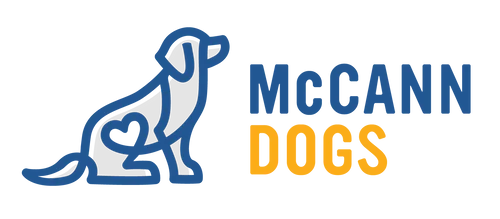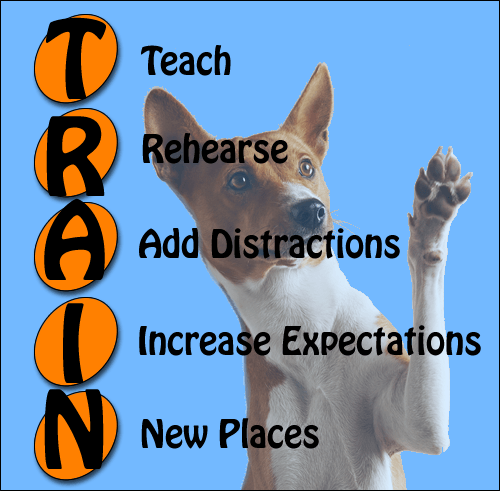![]() Listen to the Podcast
Listen to the Podcast
When people come to us asking for help with a skill they're struggling with, we can often find a step that has been left out in their training plan. As humans, it can be hard for us to understand how dogs think simply because it is different than how we think, and it can be hard to understand why you might have a perfect recall in your yard, only to watch your dog ignore you at the park. Today, we're going to talk about the steps necessary to train and perfect a skill from start to finish using our favourite acronym - "T.R.A.I.N."
T - Teach
The teaching phase is the first step. We need to spend time teaching the dog what we want, first in a quiet environment, like the living room, kitchen or backyard. Using a training method that is conducive to the skill you're teaching, show the dog how to be right! It's important to keep working at this stage until your dog has full understanding of the perfect picture. Using sit as an example, you would want to ensure your dog can physically complete the skill before you start to make things harder. Remember that if you're working with a puppy, not only are they learning how to perform that particular skill, but they're also learning how to read your body language and cuing system, so don't rush through this step!
R - Rehearse
Rehearsal is important! Repetition of the proper way to perform a skill will go a long way toward filling your dog's memory bank, which they will rely on in the future steps. Spend time on repetition of the skills that are important to you so that your dog has the best chance for success! It is widely accepted that dogs need many repetitions over a few different environments before they truly understand a new skill. Dogs don't generalize as humans do, so repetition may be the missing piece if you're not getting the results you'd like with any given skill.
A - Add Distractions
If you are training your dog with the hopes that they will respond to your cues in busy environments as well as quiet ones, you've got to add distractions to your training program! Never underestimate the power of the 'set up' to help your dog learn how to work through challenges in the environment. This is the stage to start adding distractions. Start small and build to the point where your dog is unflappable. This stage will build a history of reinforcement that will help your dog learn how to generalize their skills regardless of what might catch their attention.
I - Increase Expectations
This is my favourite stage! Throw a world of challenges at your dog and watch them blossom!!! Be creative and have faith that your dog can handle your high expectations. For example, I want my dog to understand the word sit, so I'm going to challenge him and make sure that he can sit if I'm standing, lying down, turned away from him, jumping up and down. I want to make sure he can sit while he's on carpet and tile or while he's on the couch. I want to be certain that he can sit even if I toss a toy or food. This is the stage where I really challenge my dog's understanding through tougher criteria and harder distractions. Spend even a few minutes in this stage with your dog and you'll see their confidence start to blossom as they work to get it right.
N - New Places
Now it's time to take it on the road! Find as many new locations to practise in as you can. The more you play, the more your dog learns. Put in the effort with new challenges in new places and your skill will shine. Think of this as your lifetime maintenance stage. In fact, continued training throughout your dog's life can be done in these last 3 stages. Dog skills are all about 'use it or lose it', so don't think you get to rest on your laurels at this point. Regular reminders throughout your dog's life will ensure their skills remain fresh and reliable.
Training will give you results, but only thorough training will give you solid results across all avenues of distraction.
As always, Happy Training!

